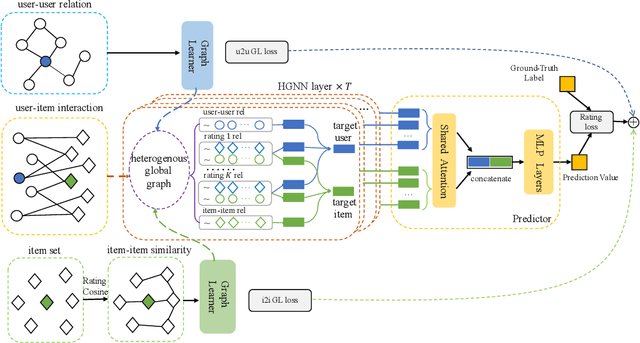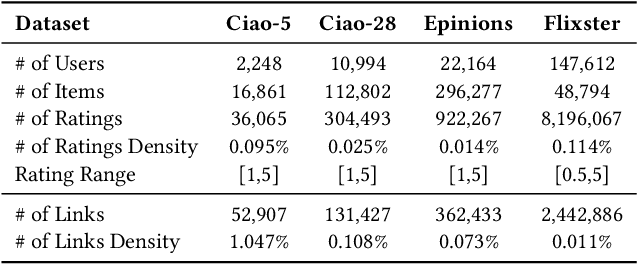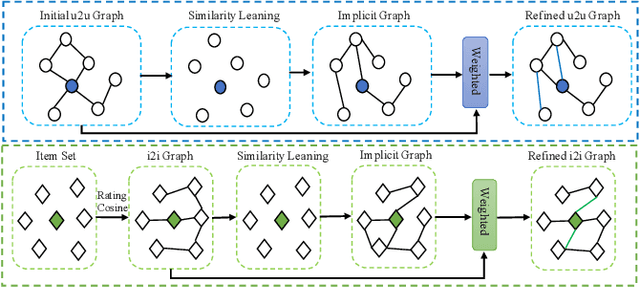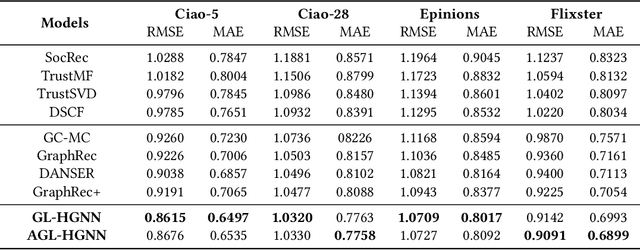Qi Shen
Towards Evaluating the Robustness of Automatic Speech Recognition Systems via Audio Style Transfer
May 15, 2024



Abstract:In light of the widespread application of Automatic Speech Recognition (ASR) systems, their security concerns have received much more attention than ever before, primarily due to the susceptibility of Deep Neural Networks. Previous studies have illustrated that surreptitiously crafting adversarial perturbations enables the manipulation of speech recognition systems, resulting in the production of malicious commands. These attack methods mostly require adding noise perturbations under $\ell_p$ norm constraints, inevitably leaving behind artifacts of manual modifications. Recent research has alleviated this limitation by manipulating style vectors to synthesize adversarial examples based on Text-to-Speech (TTS) synthesis audio. However, style modifications based on optimization objectives significantly reduce the controllability and editability of audio styles. In this paper, we propose an attack on ASR systems based on user-customized style transfer. We first test the effect of Style Transfer Attack (STA) which combines style transfer and adversarial attack in sequential order. And then, as an improvement, we propose an iterative Style Code Attack (SCA) to maintain audio quality. Experimental results show that our method can meet the need for user-customized styles and achieve a success rate of 82% in attacks, while keeping sound naturalness due to our user study.
Text2Bundle: Towards Personalized Query-based Bundle Generation
Oct 27, 2023



Abstract:Bundle generation aims to provide a bundle of items for the user, and has been widely studied and applied on online service platforms. Existing bundle generation methods mainly utilized user's preference from historical interactions in common recommendation paradigm, and ignored the potential textual query which is user's current explicit intention. There can be a scenario in which a user proactively queries a bundle with some natural language description, the system should be able to generate a bundle that exactly matches the user's intention through the user's query and preferences. In this work, we define this user-friendly scenario as Query-based Bundle Generation task and propose a novel framework Text2Bundle that leverages both the user's short-term interests from the query and the user's long-term preferences from the historical interactions. Our framework consists of three modules: (1) a query interest extractor that mines the user's fine-grained interests from the query; (2) a unified state encoder that learns the current bundle context state and the user's preferences based on historical interaction and current query; and (3) a bundle generator that generates personalized and complementary bundles using a reinforcement learning with specifically designed rewards. We conduct extensive experiments on three real-world datasets and demonstrate the effectiveness of our framework compared with several state-of-the-art methods.
Towards Multi-Subsession Conversational Recommendation
Oct 20, 2023Abstract:Conversational recommendation systems (CRS) could acquire dynamic user preferences towards desired items through multi-round interactive dialogue. Previous CRS mainly focuses on the single conversation (subsession) that user quits after a successful recommendation, neglecting the common scenario where user has multiple conversations (multi-subsession) over a short period. Therefore, we propose a novel conversational recommendation scenario named Multi-Subsession Multi-round Conversational Recommendation (MSMCR), where user would still resort to CRS after several subsessions and might preserve vague interests, and system would proactively ask attributes to activate user interests in the current subsession. To fill the gap in this new CRS scenario, we devise a novel framework called Multi-Subsession Conversational Recommender with Activation Attributes (MSCAA). Specifically, we first develop a context-aware recommendation module, comprehensively modeling user interests from historical interactions, previous subsessions, and feedback in the current subsession. Furthermore, an attribute selection policy module is proposed to learn a flexible strategy for asking appropriate attributes to elicit user interests. Finally, we design a conversation policy module to manage the above two modules to decide actions between asking and recommending. Extensive experiments on four datasets verify the effectiveness of our MSCAA framework for the MSMCR setting.
Video and Audio are Images: A Cross-Modal Mixer for Original Data on Video-Audio Retrieval
Aug 26, 2023



Abstract:Cross-modal retrieval has become popular in recent years, particularly with the rise of multimedia. Generally, the information from each modality exhibits distinct representations and semantic information, which makes feature tends to be in separate latent spaces encoded with dual-tower architecture and makes it difficult to establish semantic relationships between modalities, resulting in poor retrieval performance. To address this issue, we propose a novel framework for cross-modal retrieval which consists of a cross-modal mixer, a masked autoencoder for pre-training, and a cross-modal retriever for downstream tasks.In specific, we first adopt cross-modal mixer and mask modeling to fuse the original modality and eliminate redundancy. Then, an encoder-decoder architecture is applied to achieve a fuse-then-separate task in the pre-training phase.We feed masked fused representations into the encoder and reconstruct them with the decoder, ultimately separating the original data of two modalities. In downstream tasks, we use the pre-trained encoder to build the cross-modal retrieval method. Extensive experiments on 2 real-world datasets show that our approach outperforms previous state-of-the-art methods in video-audio matching tasks, improving retrieval accuracy by up to 2 times. Furthermore, we prove our model performance by transferring it to other downstream tasks as a universal model.
Data-Augmented Counterfactual Learning for Bundle Recommendation
Oct 19, 2022



Abstract:Bundle Recommendation (BR) aims at recommending bundled items on online content or e-commerce platform, such as song lists on a music platform or book lists on a reading website. Several graph based models have achieved state-of-the-art performance on BR task. But their performance is still sub-optimal, since the data sparsity problem tends to be more severe in real bundle recommendation scenarios, which limits graph-based models from more sufficient learning. In this paper, we propose a novel graph learning paradigm called Counterfactual Learning for Bundle Recommendation (CLBR) to mitigate the impact of data sparsity problem and improve bundle recommendation. Our paradigm consists of two main parts: counterfactual data augmentation and counterfactual constraint. The main idea of our paradigm lies in answering the counterfactual questions: "What would a user interact with if his/her interaction history changes?" "What would a user interact with if the bundle-item affiliation relations change?" In counterfactual data augmentation, we design a heuristic sampler to generate counterfactual graph views for graph-based models, which has better noise controlling than the stochastic sampler. We further propose counterfactual loss to constrain model learning for mitigating the effects of residual noise in augmented data and achieving more sufficient model optimization. Further theoretical analysis demonstrates the rationality of our design. Extensive experiments of BR models applied with our paradigm on two real-world datasets are conducted to verify the effectiveness of the paradigm
Intention Adaptive Graph Neural Network for Category-aware Session-based Recommendation
Dec 31, 2021



Abstract:Session-based recommendation (SBR) is proposed to recommend items within short sessions given that user profiles are invisible in various scenarios nowadays, such as e-commerce and short video recommendation. There is a common scenario that user specifies a target category of items as a global filter, however previous SBR settings mainly consider the item sequence and overlook the rich target category information in this scenario. Therefore, we define a new task called Category-aware Session-Based Recommendation (CSBR), focusing on the above scenario, in which the user-specified category can be efficiently utilized by the recommendation system. To address the challenges of the proposed task, we develop a novel method called Intention Adaptive Graph Neural Network (IAGNN), which takes advantage of relationship between items and their categories to achieve an accurate recommendation result. Specifically, we construct a category-aware graph with both item and category nodes to represent the complex transition information in the session. An intention-adaptive graph neural network on the category-aware graph is utilized to capture user intention by transferring the historical interaction information to the user-specified category domain. Extensive experiments on three real-world datasets are conducted to show our IAGNN outperforms the state-of-the-art baselines in the new task.
Temporal aware Multi-Interest Graph Neural Network For Session-based Recommendation
Dec 31, 2021



Abstract:Session-based recommendation (SBR) is a challenging task, which aims at recommending next items based on anonymous interaction sequences. Despite the superior performance of existing methods for SBR, there are still several limitations: (i) Almost all existing works concentrate on single interest extraction and fail to disentangle multiple interests of user, which easily results in suboptimal representations for SBR. (ii) Furthermore, previous methods also ignore the multi-form temporal information, which is significant signal to obtain current intention for SBR. To address the limitations mentioned above, we propose a novel method, called \emph{Temporal aware Multi-Interest Graph Neural Network} (TMI-GNN) to disentangle multi-interest and yield refined intention representations with the injection of two level temporal information. Specifically, by appending multiple interest nodes, we construct a multi-interest graph for current session, and adopt the GNNs to model the item-item relation to capture adjacent item transitions, item-interest relation to disentangle the multi-interests, and interest-item relation to refine the item representation. Meanwhile, we incorporate item-level time interval signals to guide the item information propagation, and interest-level time distribution information to assist the scattering of interest information. Experiments on three benchmark datasets demonstrate that TMI-GNN outperforms other state-of-the-art methods consistently.
Multi-Choice Questions based Multi-Interest Policy Learning for Conversational Recommendation
Dec 22, 2021



Abstract:Conversational recommendation system (CRS) is able to obtain fine-grained and dynamic user preferences based on interactive dialogue. Previous CRS assumes that the user has a clear target item. However, for many users who resort to CRS, they might not have a clear idea about what they really like. Specifically, the user may have a clear single preference for some attribute types (e.g. color) of items, while for other attribute types, the user may have multiple preferences or even no clear preferences, which leads to multiple acceptable attribute instances (e.g. black and red) of one attribute type. Therefore, the users could show their preferences over items under multiple combinations of attribute instances rather than a single item with unique combination of all attribute instances. As a result, we first propose a more realistic CRS learning setting, namely Multi-Interest Multi-round Conversational Recommendation, where users may have multiple interests in attribute instance combinations and accept multiple items with partially overlapped combinations of attribute instances. To effectively cope with the new CRS learning setting, in this paper, we propose a novel learning framework namely, Multi-Choice questions based Multi-Interest Policy Learning . In order to obtain user preferences more efficiently, the agent generates multi-choice questions rather than binary yes/no ones on specific attribute instance. Besides, we propose a union set strategy to select candidate items instead of existing intersection set strategy in order to overcome over-filtering items during the conversation. Finally, we design a Multi-Interest Policy Learning module, which utilizes captured multiple interests of the user to decide next action, either asking attribute instances or recommending items. Extensive experimental results on four datasets verify the superiority of our method for the proposed setting.
Multi-behavior Graph Contextual Aware Network for Session-based Recommendation
Sep 24, 2021



Abstract:Predicting the next interaction of a short-term sequence is a challenging task in session-based recommendation (SBR).Multi-behavior session recommendation considers session sequence with multiple interaction types, such as click and purchase, to capture more effective user intention representation sufficiently.Despite the superior performance of existing multi-behavior based methods for SBR, there are still several severe limitations:(i) Almost all existing works concentrate on single target type of next behavior and fail to model multiplex behavior sessions uniformly.(ii) Previous methods also ignore the semantic relations between various next behavior and historical behavior sequence, which are significant signals to obtain current latent intention for SBR.(iii) The global cross-session item-item graph established by some existing models may incorporate semantics and context level noise for multi-behavior session-based recommendation. To overcome the limitations (i) and (ii), we propose two novel tasks for SBR, which require the incorporation of both historical behaviors and next behaviors into unified multi-behavior recommendation modeling. To this end, we design a Multi-behavior Graph Contextual Aware Network (MGCNet) for multi-behavior session-based recommendation for the two proposed tasks. Specifically, we build a multi-behavior global item transition graph based on all sessions involving all interaction types. Based on the global graph, MGCNet attaches the global interest representation to final item representation based on local contextual intention to address the limitation (iii). In the end, we utilize the next behavior information explicitly to guide the learning of general interest and current intention for SBR. Experiments on three public benchmark datasets show that MGCNet can outperform state-of-the-art models for multi-behavior session-based recommendation.
Graph Learning Augmented Heterogeneous Graph Neural Network for Social Recommendation
Sep 24, 2021



Abstract:Social recommendation based on social network has achieved great success in improving the performance of recommendation system. Since social network (user-user relations) and user-item interactions are both naturally represented as graph-structured data, Graph Neural Networks (GNNs) have thus been widely applied for social recommendation. In this work, we propose an end-to-end heterogeneous global graph learning framework, namely Graph Learning Augmented Heterogeneous Graph Neural Network (GL-HGNN) for social recommendation. GL-HGNN aims to learn a heterogeneous global graph that makes full use of user-user relations, user-item interactions and item-item similarities in a unified perspective. To this end, we design a Graph Learner (GL) method to learn and optimize user-user and item-item connections separately. Moreover, we employ a Heterogeneous Graph Neural Network (HGNN) to capture the high-order complex semantic relations from our learned heterogeneous global graph. To scale up the computation of graph learning, we further present the Anchor-based Graph Learner (AGL) to reduce computational complexity. Extensive experiments on four real-world datasets demonstrate the effectiveness of our model.
 Add to Chrome
Add to Chrome Add to Firefox
Add to Firefox Add to Edge
Add to Edge